Within is the complete list of Ranji Trophy winners and runners-up according to chronological order. The initial source is from Cricinfo and subsequent updates will be as I follow the seasons.Year Winners Runners-up 1934-35 Mumbai Northern India 1935-36 Mumbai Madras 1936-37 Nawanagar Bengal 1937-38 Hyderabad Nawanagar 1938-39 Bengal Southern Punjab 1939-40 Maharashtra United Province 1940-41 Maharashtra Madras 1941-42 Mumbai Mysore 1942-43 Baroda Hyderabad 1944-45 Mumbai Holkar 1945-46 Holkar Baroda 1946-47 Baroda Holkar 1947-48 Holkar Mumbai 1948-49 Mumbai Baroda 1949-50 Baroda Holkar 1950-51 Holkar Gujarat 1951-52 Mumbai Holkar 1952-53 Holkar Bengal 1953-54 Mumbai Holkar 1954-55 Madras Holkar 1955-56 Mumbai Bengal 1956-57 Mumbai Services 1957-58 Baroda Services 1958-59 Mumbai Bengal 1959-60 Mumbai Mysore 1960-61 Mumbai Rajasthan 1961-62 Mumbai Rajasthan 1962-63 Mumbai Rajasthan 1963-64 Mumbai Rajasthan 1964-65 Mumbai Hydeabad 1965-66 Mumbai Rajasthan 1966-67 Mumbai Rajasthan 1967-68 Mumbai Madras 1968-69 Mumbai Bengal 1969-70 Mumbai Rajasthan 1970-71 Mumbai Maharashtra 1971-72 Mumbai Bengal 1972-73 Mumbai Tamil Nadu 1973-74 Karnataka Rajasthan 1974-75 Mumbai Karnataka 1975-76 Mumbai Bihar 1976-77 Mumbai Delhi 1977-78 Karnataka Uttar Pradesh 1978-79 Delhi Karnataka 1979-80 Delhi Mumbai 1980-81 Mumbai Delhi 1981-82 Delhi Karnataka 1982-83 Karnataka Mumbai 1983-84 Mumbai Delhi 1984-85 Mumbai Delhi 1985-86 Delhi Haryana 1986-87 Hyderabad Delhi 1987-88 Tamil Nadu Railways 1988-89 Delhi Bengal 1989-90 Bengal Delhi 1990-91 Haryana Mumbai 1991-92 Delhi Tamil Nadu 1992-93 Punjab Maharashtra 1993-94 Mumbai Bengal 1994-95 Mumbai Punjab 1995-96 Karnataka Baroda 1996-97 Mumbai Delhi 1997-98 Karnataka Uttar Pradesh 1998-99 Karnataka madhya Pradesh 1999-00 Mumbai Hyderabad 2000-01 Baroda Railways 2001-02 Railways Baroda 2002-03 Mumbai Tamil Nadu 2003-04 Mumbai Tamil Nadu 2004-05 Railways Punjab 2005-06 Uttar Pradesh Bengal 2006-07 Mumbai Bengal 2007-08 Delhi Uttar Pradesh
Sunday, August 31, 2008
Ranji Trophy Winners - The Complete List
Posted by Soulberry
Sunday, August 24, 2008
The Origins of Ranji Trophy - Part IV
Posted by Soulberry
The Impostor
The post-lunch session saw us engrossed with a multi-layered deep game played on and off the field. The narrator calls us back into a huddle for the final session of the innings.
The proposal for a more inclusive domestic tournament on an All-India range was mooted in the Simla meet of 1934. HH Bhupinder Singh ji, Mahajadhiraj of Patiala, donated a sum of £ 500 towards the design of the trophy, the configuartion of which, he also proposed, besides naming it after Ranji, who had recently passed away. He had also offered to present miniature trophy to the winners for keeps. All his proposals were accepted and he was back on the track...just the home stretch remained.
Curiously, the public announcement was delayed, giving time for Vizzy to catch up with the new developments. A trophy must be matched with a trophy, which must appear more worthy to the powers that be.
An emergency meeting of the Board was summoned. Vizzy argued against naming the trophy after Ranji by placing the facts on the table that Ranji had done little for Indian cricket and had a highly limited involvement with the game in India. He suggested that it should be named after Lord Willingdon instead! Vizzy even offered to sponsor the trophy himself.
The meeting was attended by all the heavyweights of the board - Sir Sikander Hayat Khan, Nawabzada Liaqat Ali Khan, Patiala, RE Grant-Govan, Anthony S D'Mello and Vizzy.
The motion was passed without resistance or fuss. Patiala couldn't prevent the flip-flop over Ranji Trophy, for this one was named after the sitting Viceroy! None of the royal favour curries on the cricket board dared go against that!
Lady Willingdon, the Vicereine, herself selected the trophy, which was named The Willingdon Trophy and kept on public display.
Naturally, Patiala was quite miffed.
The rivalry between the two warring protagonists peaked in the finals of the Moin-ud-Dowlah Trophy between their respective teams at Hyderabad - Freebooters vs Retrievers.
Vizzy's Freebooters boasted of Learie Constantine in their ranks while Patiala's Retrievers were led by the young Yuvraj of Patiala.
It is said 15,000 spectators turned up at the Gymkhana Grounds of Secunderabad to witness this match. Surprisingly, Vizzy himself didn't take part in the match. It is said, he telegrammed Learie during the match promising an amount in pounds for every run scored and wicket taken. Unfortunately, it all came to naught, as we can see from the scorecard....The Retrievers won by three wickets.
In a sense, it was a metaphorical message for Vizzy.
There was public outcry in the press when the details were revealed. Ranji vs Willingdon assumed nationalistic colours in that charged atmosphere of the ongoing freedom struggle. Writers felt it was sacrilege to the memory of Ranji, who was, despite all, the greatest cricketer ever born in India. However cynicism reigned, despite the brave outrage, the general feeling was that the impostor would be awarded to the winning team of the first national championship 1935 - Bombay.
HJ Vajifdar deputizing for the indisposed Bombay captain, LP Jai, walked upto to receive the Willingdon Trophy one week after the match at a public exhibition of the trophy. Lord Willingdon himself was present on the podium to award it. There wasn't a single unsurprised soul in the gathering which witnessed Lord Willingdon switch trophies and award the Ranji Trophy instead!
Truly a case of one impostor setting the record right through another impostor!
And so, this was how Ranji Trophy, the tournament and trophy, came into being.
EPILOGUE
How did that happen? What prompted such drama from Lord Willingdon? It turns out the surprise was hatched in distant England as yet another move in the princely game of chess played between Patiala and Vizzy.
Patiala and Grant-Govan were in London to attend the ICC meeting at Lord's. Grant-Govan broached and Patiala promised that he'd fund Jack Ryder's Australians on their scheduled trip to India later in 1935. Hence, the Ranji Trophy was awarded.
The princely battles continued beyond, but India had a domestic championship of its own with a nice trophy named after the greatest cricketer born here, even if he didn't play for India. This is story that lay behind this little scrap one began with -

Soulberry adds:
Patronage, money and purchasing, encouraging rivalries between groups by patrons, strategies, subterfuge...all these are intrinsic to Indian cricket. Perhaps then it was a compulsion of slavery and subjugation, but such continue into the present day. The story of how the Ranji Trophy came into being is no different from the recent setting up of IPL...the protagonists may be different, the boundaries may be liberal, the amounts far greater, the stakes as high, and the games and countergames by rival parties the same. Like with the Ranji trophy then, it was with IPL now...India did manage to set up a structure to strengthen its cricket and matching the demands of the respective eras, and it managed to have a trophy of its own despite all!
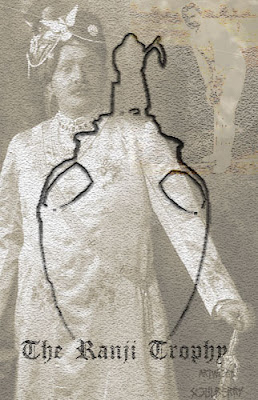
Knowing the troubled birth of this trophy must remind Indians - players, adminstrators and spectators - to give Ranji Trophy the status it truly deserves in our cricket.
And there is more to Ranji, but that's for another post. This fourth part concludes the series of blogs dicussing the origin of our domestic championship and trophy.
References and Links:
- The Origins of Ranji Trophy - Part I
- The Origins of Ranji Trophy - Part II
- The Origins of Ranji Trophy - Part II
The Origins of Ranji Trophy - Part III
Posted by Soulberry
Oh, To be my nation's first captain! And proxy wars thereof
At lunch, we were left mulling the seriousness attached to a game by grown up men with varying degrees of power and wealth. A game we quickly set up with one log of wood, a ball, and three bricks, on the torn and worn asphalt pitches of narrow gullies binding our homes. The thought that men fought over it, spent inheritances on it, nations fought over a game can push one into a thoughtful repose...they all still do the same, don't they?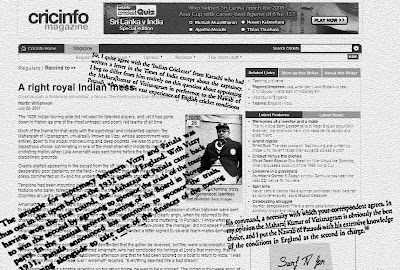
But our narrator is ready with yet another twist in the tale, yet another round of sparring, of landing punches and counter punchins, of feints, bluffs and counter-feints. The Trophy indeed was gestated without hurry. We must be therefore be attentive, lest we miss...
All that had happened earlier was a build up from the main rivals towards the much sought after captaincy of the first Indian cricket team. Nothing more, nothing less, for being the country's cricket captain was percieved to be the acme of power one could enjoy under the British colonial system. Royals, who some claim, are simply the wiliest and strongest rogues of all, anywhere in the world, were more prone to take these matters to heart than the ordinary man.
When Vizzy appeared to have done enough to completely displace Patiala, Bhupinder Singh ji threw in a late jab, hoping it would find its mark. he agreed to sponsor the trials and bear one month's expenses of the touring party. With a flailing stroke, he was almost back on even keel and in with a chance to captain India again.
But other players were also in...shooting for a chance.
To push his case along, the Nawab of Pataudi Sr issued a statement suggesting his willingness to concede his Worcestershire qualification if he were selected to play for India. Considering that his selection was beyond doubt, it was felt there was a suggestion in it towards captaincy.
Letters of support and counter-support for various candidates began to appear in the newspapers of that time. Some of them were authored under unknown pseudonyms. Today, we all correspond over the net under such pseudonyms - concealment of identity on the web is considered a form of security - in times gone by, such methods were frowned upon but used nevertheless strategically.
Pataudi Sr, Vizzy, Patiala, Duleepsinhji and KS Ghanshaymsinhji were some of the names in the fray. The nation waited with bated breath to learn of their captain as the meeting convened on 4th February 1932, at 3.30 pm in the afternoon.
Perhaps it was the consistent financial support and the offer to sponsor the trials which did it - HH Maharajaadhiraj Maharaja of Patiala Bhupinder Singh ji was nominated the first captain of the Indian cricket team. It was a nomination which evoked debate and partisan views in the press of that time.
While a section claimed it to be a tribute to his highness's efforts over a long time, others questioned his skills, form, tactical and leadership abilities. At best, such felt, Bhupinder Singh, could be a non-playing captain.
Vizzy left no one in doubt about what he thought about the decision of the board. He decided to withdraw from the tour, ostensibly on grouds of poor health, and work instead on Lord Willingdon. Such is what our narrator tells us.
He wrote to the board citing his excuses, expresing his anguish and at the same time thanking the board for selecting him for the tour.
Vizzy immediately donated a pavilion to the newly constructed Ferozeshah Kotla Stadium and named it after Lord Willingdon, in an attempt to strengthen his position with the powers that were.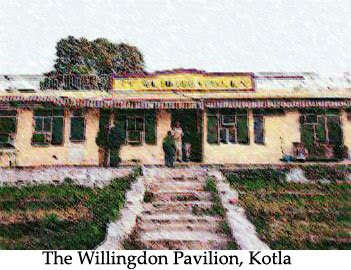
The erstwhile Willingdon Pavilion at Feroze Shah Kotla, New Delhi, donated by Vizzy. Now it has been replaced after rennovations to the ground
In reponse, Bhupinder Singh ji pulled off a political masterstroke of his own to kill two birds with one stone - to conceal his own poor ability and form, and to retrieve the thunder Vizzy again appeared to have stolen.
Having made his point by being selected as first-choice captain, the powerful one among the gaming satraps of Indian cricket relinquished his appointment to the surprise of one and all. He too thanked the board and gushed about the privilige of leading the country like Vizzy, and offerred existing state situation as an excuse for his inability to get away to play cricket.
The Maharaja of Porbander thus became the Captain of India by two defaults.
He was the worst player on the team scoring a total of two runs in the first class games leading up to the Test match. However, he was sensible enough to give up his captaincy to CK Nayudu. Therefore, much as the royals craved and plotted, ultimately it was a commoner who led India in its first test match.
Meanwhile, as a result of Vizzy's donations and attentions to Lord Willingdon, The balance of power began to slip away from Patiala. The associations which earlier fed off him began to wean themselves away from him. Or so says Mihir Bose, in his History of Indian Cricket.
Patiala began to play his cards fast as well, refusing to give up easily.
He entertained the visiting MCC team lavishly during their Indian sojourn, with all the special eastern thrills which excited colonial Englishmen. So much so, that after sessions of hunting in the Himalayas, the stiff Douglas Jardine was also melted over.
Next, he withdrew himself from all contests for active playing positions and responsibilities and pushed forward the young Yuvraj of Patiala, Yadvindra Singh ji, who was a more capable cricket player.
CK Nayudu was played up by Vizzy depite being a poor captain and Vizzy used that discontent to make his way forward. He won a game against the visiting MCC team of Douglas Jardine, which added a halo to him. There was further sheen when Jardine praised his potential to be India captain.
Meanwhile, Ranji, who was in the employment of Patiala's cricketing XI, passed away.
Patiala responded to setbacks by yet again turning towards the less promiment.
With the Bombay Pentangulars suspended, the need for a proper, All-India domestic tournament was felt as an immediate necessity by the board. the Mayor of Bombay suggested so when the Indian team returned from England in 1932. However, it was much earlier, in 1928 when the Board for Control of Cricket in India was set up, that it was felt such a system would strengthen the cricketing abilities of the nation.
In 1934 Simla meet, Anthony S D'Mello emphasized the need for such a tournament. Patiala sensed and seized the moment yet again - he stood up and donated immediately, the sum of £ 500 for the trophy along with a description of what it was to look like - "Grecian urn two feet high, with a lid, the handle of which represented Father Time, similar to the one on the weather vane at Lord's."
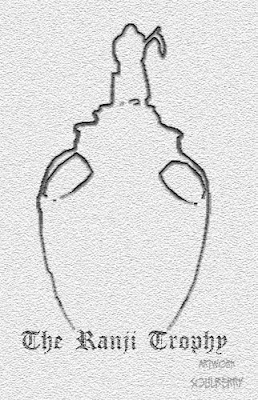
He also expressed his desire that the trophy be named after Ranji, to honor Ranji's contribution to the game. here was also an offer to present a miniature to the winning team for keepsakes.
The Maharaja of Patiala's suggestions and offer were well recieved. It looked like Ranji Trophy would soon be born.
-- End of Part - III --
References and Links:
Saturday, August 23, 2008
The Origins of Ranji Trophy - Part II
Posted by Soulberry
The social ascension of HH The Maharajkumar Sir Pusapati Gajapatiraju Vijaya Ananda "Vizzy"
When we broke off for the first drink's break, the narrator had introduced us to the scene, climes, and some of the characters who unwittingly ended up creating the Ranji trophy. The narrator also introduced us to the two main protagonists responsible, documenting their rivalry, and the declining influence of the powerful Maharajah of Patiala, due to recorded scandalous misdemeanours, in the court of the Viceroy, Lord Willingdon, which was matched by the sudden concurrent rise in prestige of his bête noire - Maharajkumar of Vizianagaram. He had left us there, tantalizingly poised to see Vizzy rise in court from his remarkable challenge. Before we go on, let us briefly understand Vizzy.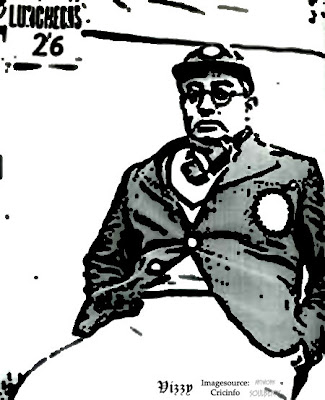
Unlike the powerful and ruling Maharajadhiraj Bhupinder Singh ji of Patiala, Vizzy was the second son of Maharaja Sahib Pusapati Chittibabu Vijayarama IV Gajapathi. Thus he was not in direct line of power, and hence a Mahrajkumar. Then, he had a disagreement with his nephew, following which, he had to shift base from his southern Kingdom of Vizianagaram to Benares (Varanasi) where he married Maharajkumari Bhagirath Devi of Kashipur and settled down. However, it is said, he was an ambitious man, determined to cultivate his own power and influence through the plough of cricket.
Mihir Bose has famously written in his book, A History of Indian Cricket, "If Vizzy had been content with being such a cricket sponsor like Sir Horatio Mann in the eighteenth century, or Sir Julien Cahn in the twentieth, his name would be one of the most revered in Indian cricket. But he was consumed with the ambition to be a great cricketer".
It is a famous quote, often seen on the web, included on Vizzy's page at Wiki, and perhaps summarizes what, or sets the tone for how, most authors may feel about Vizzy. It is true perhaps that Vizzy dreamt of leading India as captain, in what was merely a sport otherwise, but had assumed far different dimensions then as it continues to wear now.
So here is a young man, born into monarchy, and with an inclination to rule, living in a period when power and patronage were still tantalizingly near, even though these essentials were slipping away swiftly and certainly from the grasp of traditional rulers, with great organizational skills, and some lesser ones in the most useful of places - on the cricket field of colonial India. He used them both to replace the firmly entrenched Patiala from close proximity to Lord Willingdon, Chief Patron of cricket in India and also the Viceroy of that time. At least for a while Vizzy was King.
Vizzy organized and led a team on a tour of Ceylon versus Dr. J Rockwood's Europeans in 1930-31, and cricket playing centres of India such as Delhi, Calcutta (now Kolkatta), Madras(now Chennai), Bangalore ( now Bengaluru ), Secunderbad and Benares ( Varanasi). ( More related stats - here and the controversies thereof re: Hobbs and Sutcliffe) The Indian part of the contingent included senior players such as CK Nayudu, Mushtaq Ali, and Prof. D.B Deodhar.
Getting Hobbs and Sutcliffe to play was no mean feat, we are told, for Hobbs had spurned five previous offers. Fans of Kevin Pietersen in India hoping to see him play in the IPL, therefore, still have four hopes to go! Vizzy spent his own money in setting up this team and organizing the tour, the success of which, not only drew apprecation from Sutcliffe (who went on to record it the Daily Express of that time), but also catapulted his stock in the cricket establishment of India to dizzy heights.
Our narrator tells us that Times of India reported then that Nawab Liaquat Ali Khan, the President of the Cricket Control Board, en route attending the second round table conference at Bombay, disclosed th convening of an emergency board meeting at Simla in which issues relating to office bearers, th proposed tour of England and the visit of Ceylon were discussed. He also diclosed that Vizzy had announced a purse of Rupees 50,000 towards the forthcoming tour of England. Anthony S D'Mello, RE Grant Govan, and CE Newham (who was acting president) were said to be sitting in the meeting.
The seed for captaincy of the Indian team was clearly being tended to vigorously.
At this point I may need to digress a little and discuss a point with our narrator for I am confuse about the Liaqat Ali Khan involved with both round tables and cricket besides being a Nawab in the bargain.
Extensive research on the net ( please refer to the difficulties I mentioned earlier in the absence of a BCCI website ) by me on Nawabzada Liaqat Ali Khan for his affiliation and association with cricket adminstration of that time revealed nothing.
The BCCI list of presidents also dos not reveal the name of the Nawab. However, our narrator has quoted Times of India and I do not have access to their archives of that period. There are however Sikandar Hayat Khan and Mohammed Hamidullah Khan on the list approximating that period. Well, that's one for our narrator to clarify. I welcome anyone who points me in the right direction.
We are told, Vizzy upon reaching Delhi after being invited for a meeting with the powers that be, issued a stirring statement of aims in which he claimed he had ndertaken the journey for the sake of cricket, endeavoring for the materialization of the proposed tour of England, and that he was willing to sacrifice wealth and much for the sake of the game and the tour.
News reports of that time, we are told, in the light of the successful organization of the Ceylon and India tour and generosity, concluded their articles with a declaration that Vizzy's appointment as captain to England was a certainity.
The viceregal doors opened and Vizzy was at discussions with Lord Willingdon over the proposal and details of the tour of England. Willingdon is said to have been deeply interested in favour of the project. Clearly Vizzy had closer to the seat of power while the colourful Patiala had slipped away from it.
Not so...things are not so clear-cut in princely thrusts and parry's.
Patiala decided to redeem his eroding status by offering to cover the expenses of the trials involved for the team's selection and a month's expenses on tour. The hitherto impoverished Board was truly overwhelmed by the windfalls of rivalry.
Also, with the rivalry no longer covert, it gave opportunity to others to shape things along. The Jama Saheb Nawab of Nawanagar, who invented a delicately cruel stroke to survive and thrive in competitive counties saw a chance to create an impresion in India as well. Similarly, there were those, who through correspondence with newspapers, anonymously or otherwise, threw in the crown of the Nawab of Pataudi - Iftikhar Ali Khan, and others' as well into the captaincy stakes.
-- End of Part II --
References:
The Origins of Ranji Trophy - Part I
Posted by Soulberry
Of princely intrigues, courting colonial masters, and decline of Patiala's influence
One of the peculiar aspects of researching the origins of the Trophy on the net is that there is only standard material available unless you have access to very old press archives, which I obviously do not have. There are also curiously very few images of the Trophy itself in the public or purchasable domain. However, there is plenty of material available in the print world. There are many books which tell us about how it all began. I had to provoke my local bookshop owner to explore beyond his stock of cricket books and he graciously obliged: the best of the lot for me was Boria Majumdar's Once Upon a Furore : Lost Pages of Indian Cricket, published originally by an independent venture called Yoda Press, which has since handed over its catalogue to Cambridge University Press, it appears. Even at the mentioned rate, it is a bargain for this is a book worth reading and possessing. I got it for a happy discount from my regular store owner. I mention all this for the books were not easy to procure as per my experience.
Majumdar's is a compulsive style which is engrossing and is well-supported by his meticulous research which reveals to us many unknown aspects of Indian cricket unmentioned even in other respected titles. I have digressed at the outset of this blogpost itself, but it was necessary to mention this wonderful book to those who want to know about the history of Indian cricket. Boria has since gone on to author another tremendous book which is about ten times the cost of this one and contains many many details. It was also necessary for I have chosen to accept most of the information he has conveyed to us as source, and will base this post on the framework of that information. Credit given where credit is due, we move on to chew some past among us...
The world knows the simple facts about the Ranji Trophy, but the story of how it came about is a script for a drama in itself!
Not many resources (detailed enough) are available to in the form of a record or chronicle of the birth of this most important domestic competition on the net. Boria digs up the princely rivalries, court intrigues, motivated rulers, and other peripheral characters with vested interests; the different personal and public ambitions; all of which together breathed life into the sustaining seed of Indian cricket - The Ranji Trophy.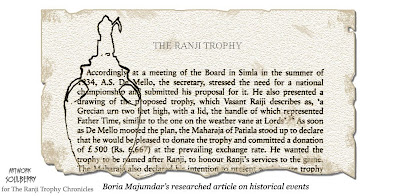
We are told (see image above), behind that innocent magnanimity in the general meeting of the Board of Cricket Control at the colonial summer capital of Simla , in the setting of pre-independent India, where former rajahs and maharajas were reduced to being mere courtiers of colonial viceroys, with little or none, power and importance, that cricket became an important plough to cultivate the colonial rulers and develop some much-needed influence to retain some relevance. We are told, that gaming cricket with the lord and overseer, surrogated for wars these decorative satraps could not wage with each other anymore. We are told how the politics of cricket in India gave Ranji his royal seat and immortality, even though he played little for and in India.
The principals in this intriguing story of the Trophy's birth, the narrator tells us, were the HH Maharaja
of Patiala, Bhupendrasingh Rajindersingh ji and the Maharajkumar of Vizianagaram "Vizzy".
We rewind to India circa pre-independent 1930s, when the Board of Control for Cricket was a newly formed body. HH Bhupindersingh ji of Patiala was among the most powerful of princes in India at that time when most had lost the majority of their powers. He was a generous patron of the game of cricket, appointed officially the vice-patron, second only to Lord Willingdon, chief patron by virtue of being the Viceroy of that era, who controlled the Board activities and donated magnanimous sums of money as well as for the construction of the Cricket Club of India ( CCI ) building. { CCI is housed in Brabourne Stadium and Raj Singh Dungarpur was its chief till recently }
The Patiala maharaj also employed senior cricketers and Ranjitsinhji was one of them. In fact, it is said, Patiala stood by Ranji in overcoming his financial crisis.
However, Patiala was also an infamous connoiseur of wondrous beings of the other kind, according to the published work of one of his disgruntled subjects in the tome Indictment of Patiala. as a result, he was gradually sinking in grace with the powers that be. It was in this self-inflicted asthenic state that Patiala found challenge, in the ambitious form of Vizzy, HH Maharajkumar of Vizianagaram.
Due to the launch of the Civil Disobedience Movement against the British by Mahatma Gandhi around that time, the proposed MCC tour was cancelled.
Vizzy saw an opportunity and jumped in to plug the gap and capitalize with a team comprising, among others, the highly influential Jack Hobbs and Herbert Sutcliffe, to tour Ceylon (Sri Lanka) and cricket-playing parts of India.
Indian giants such as Colonel CK Nayudu, Mushtaq Ali, and Prof. D.B Deodhar were also part of that tour.
The tour was an unqualified success and Sutcliffe lavished praise upon Vizzy in his columns for a newspaper. He went thus, according to our narrator -
The Maharajkumar is a candidate for the captaincy for the Indian team to tour England, and if he's fortunate enough to be appointed, he will no doubt give an excellent account of himself for he has had a through grounding in the finer points of the game, and is a most capable leader.
This "endorsement", the value of which in times such as those can be understood, fuelled Vizzy and his dreams. With greater assurance, he lobbied himself into a clearly rival position to Patiala.
-- End of Part One --
Wednesday, August 20, 2008
With A Brief Word About The BCCI Flag and Logo
Posted by Soulberry
Most cricket boards have their own comprehensive websites...curiously, BCCI continues to be an exception to that. Strangely, it continues to be without a website of its own. In such a state, one can only gather information from various sources and come up with something which might be close to the truth.
This is what I put up about India/BCCI colours and logo at The Cricket Watcher's Journal 1. This happens to be the best shot of the BCCI flag I could find on the web. That in itself is a story and wake-up call for the Indian board. However, continuing...
This happens to be the best shot of the BCCI flag I could find on the web. That in itself is a story and wake-up call for the Indian board. However, continuing...
The sporting colours of the Indian cricket team and it's logo are derived from the flag.
The light blue and gold are the primary colours with hints of the darker blue.
The origins of these colours can only be guessed.
Considering that BCCI was a colonial establishment, the light blue is symbolic of the Christian concept that light blue signifies Divine cure.
In the same vein, the yellow/gold band could represent the sparkling gold of baptism in Holy Christ.
As to the darker blue, I haven't the slightest idea and my research hasn't revealed much on it.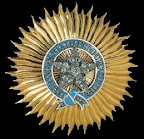 Coming to the star/sun in the center, it is derived from the Star of India 2. Some other colonial medals can also be seen at this website 3.
Coming to the star/sun in the center, it is derived from the Star of India 2. Some other colonial medals can also be seen at this website 3.
I quote from sources - "The star of the Grand Commander of the Most Exalted Order of the Star of India, the highest class of the Star of India and the star that appears all over the place on British "colonial" flags in India."
Another source - "The Most Exalted Order of the Star of India was an Order of Chivalry instituted in 1861 and discontinued in 1947. "
However, the Star of India exists, albeit in a slightly modified form, at the center of the BCCI flag. BCCI, as we know, haven't been able to completely sever the philosophical umbilical cord with England and the colonial past. It remains one the few institutions in India which haven't completely relinquished their colonial heritage. Take a look at the India cap Dravs is wearing. The Star of India is slightly modified now and instead of the pointed rays, now wears blunted rays...perhaps a concession to changed times, perhaps for graphical ease.
Take a look at the India cap Dravs is wearing. The Star of India is slightly modified now and instead of the pointed rays, now wears blunted rays...perhaps a concession to changed times, perhaps for graphical ease.
The above are the result of things I have read at different places...on the web and print. I could be wrong and would welcome suggestions. Hopefully, BCCI can construct a proper website soon enough and we can have more information about cricket in India and its history straight from the horse's mouth, so to speak.
It is possible the Star of India was used to represent all sports, and following independence in 1947, somehow it stuck with cricket and BCCI.
There is also a school of thought that the colour blue was adopted because it was thought to represent secularism, which is one of the cornerstones of India.
These are, as I said, conjectures...only BCCI can tell us where the truth lies.
It is with this that I commence a record of my impressions of domestic cricket in India.
References
- The Cricket Watcher's Journal
- Medals.org.uk

